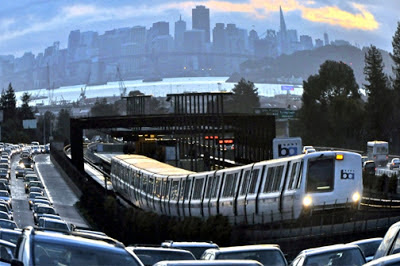Permanent Link:
There are some well meaning people who believe
that increasing the population density of Sunnyvale is a good thing
because among other things it will increase ridership of mass transit in
the area. This will lead supposedly to a virtuous cycle of greater
mass transit use leading to greater availability leading to even greater
use of mass transit leading to ever less pollution, less congestion,
and therefore more walkable, bike-friendly cities, etc., etc.
I share the goal of better mass transit but the problem here is in the numbers.
Consider the NY Subway system (see picture of a subway station below). http://en.wikipedia.org/wiki/New_York_City_Subway
The
NYC Subway system is one of the most successful mass transit systems in
the world - #7 in the world in terms of ridership, (just below
Guangzhou and just above Mexico City) and #1 in the Western Hemisphere.
c.f. http://en.wikipedia.org/wiki/Metro_systems_by_annual_passenger_rides .
It has over twice the ridership of the next 14 urban heavy rail transit systems in the US COMBINED!
http://en.wikipedia.org/wiki/List_of_United_States_rapid_transit_systems_by_ridership
c.f. http://en.wikipedia.org/wiki/Metro_systems_by_annual_passenger_rides .
It has over twice the ridership of the next 14 urban heavy rail transit systems in the US COMBINED!
http://en.wikipedia.org/wiki/List_of_United_States_rapid_transit_systems_by_ridership
AND - those next 14 include 2 based in NYC - one in Staten Island and the other for the NY-NJ commuter area.
So
any data you read about how wonderful mass transit systems are has to
include NYC to make sense. Take out NYC and all the data about
cost-effectiveness and congestion relief goes to heck. Next time someone
tells you numbers supporting mass transit ask if those numbers include NYC and what they would be with NYC factored out.
So
what about energy efficiency? Even if you don't accept the idea of
global warming, surely it is better to not have all those polluting cars
on the road? Well, the NYC Subway system consumes 2289 kJ(kilo-Joules)/passenger-km in 1995 vs 2427 kJ/passenger-km for automobile travel. (Joules are the metric unit for energy)
So the most successful mass transit system in the Western Hemisphere uses 94% of the energy of cars. If you DO accept global warming the issue is clouded by where those Joules come from. If a Joule of electricity is generated by coal (42% of US electricity production) it is far, far dirtier than the pollution coming from petroleum based cars. An all-electric car like the Nissan Leaf has the carbon footprint of a 33 MPG car like the Honda Fit in Colorado,
better in other parts of the country with hydro and gas powered plants
like California, worse in heavily coal-dependent areas like TX and PA. In 2006, more Watts of power were generated by coal in the US than in China.
http://en.wikipedia.org/wiki/Coal_power_in_the_United_States
http://en.wikipedia.org/wiki/Coal_power_in_the_United_States
There is, of course, no way that the Bay Area will ever achieve the population density of the NY metro area. Even places like Chicago that would welcome the honor can't achieve it.
There are other forms of mass transit and other virtues to mass transit besides energy efficiency and carbon footprint. It is inconceivable that NYC could work as well as it does without their subway system. BART does wonders to relieve congestion on the Bay Bridge and I have been strongly in favor of "BART around the Bay" (BARB) since I moved here in 1982.
I was horrified to read the former mayor of San Jose say they stopped BARB because San Jose's business community was afraid everyone would just take BART to go to SF so SJ would never develop a meaningful downtown. The way to grow a city is to make it hard to get to? Stupidity on that order is just breathtaking.


No comments:
Post a Comment